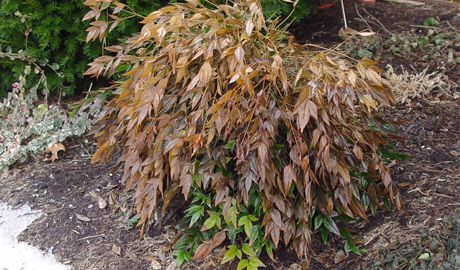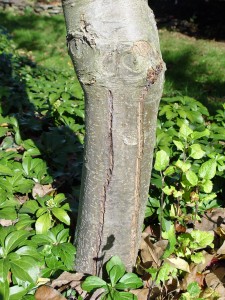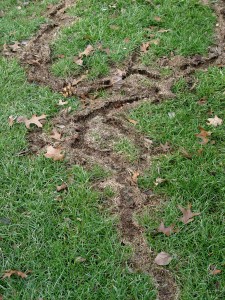Mending the Winter Damage in Your Yard

Ice storms, freezing temperatures, snow, salt… your plants have been through a lot this winter! Here are some symptoms and solutions for your yard damage.
Cold injury.
Yeah, we might see some diebacks and possibly even dead plants in cold winters in species that are borderline hardy to central Pennsylvania.
If you’ve pushed the envelope with photinia, camellia, palms, figs, loropetalum and such, colder-than-usual winters are when you might pay. Two points to keep in mind:
1.) It may not have been as cold as you think… at least not to the point of killing plants that have evolved to tolerate zero-degree lows.
2.) Winters that get cold and stay cold are better than ones that yo-yo back and forth between warm and cold.
Woody plants in the correct winter-hardiness zone (Zones 5B-7A in our case) deal with cold by “hardening” themselves over winter.
Having a consistent cold is actually less harmful than one of those yo-yo winters or worse yet when a late cold snap hits after temperatures warmed.
Again, don’t be too quick to remove cold-injured plants. Some of these plants suffer dieback of the top growth but push up new growth later in spring from the roots.
Wait until at least the end of May to see what happens. You’ll likely be able to just prune off dead wood and let new growth fill back in.
Another way winter damages trees is by freezing wood overnight and then splitting it apart vertically in the morning when sun quickly thaws it.
This expansion-related frost-crack damage happens particularly to thin-barked species such as cherry and maple, and it often happens on the eastern (i.e. morning-sun) exposure.
The good news is that most trees grow out of this. If the tree is otherwise healthy, it will put out callus (tissue) and heal the wound. So there is no need to paint or tar these splits.
Winterburn.
Evergreens – especially broad-leaf ones, such as holly, cherry laurel, nandina and boxwood – might look browned and beaten toward the end of a cold winter. Most of that leaf injury is due to cold winter winds.
What happens is that wind continues to sap moisture from the leaves over the winter, but the frozen ground doesn’t allow the roots to replace that loss. The result is browning around the leaf tips and margins.
An end-of-winter pruning or shearing back to live wood will fix almost all of this. Given a month or two of new growth, most of these winter-burned evergreens will be as good as new.
Salt damage.
This one’s more insidious. The sodium in all of that road salt and bags of rock salt can interfere with the ability of plant roots to take up moisture.
Excess salt in the soil also can make the soil more compacted, which interferes with root growth.
Both of those show up in summer leaf-browning symptoms that usually get blamed on heat and drought.
Soaking spring rains are the best antidote for sodium overload – both for salt spray on foliage and salty melt-water in lawns and beds.
If we don’t get that, consider several good soakings with a hose, especially to beds along roads, walks, driveways and other areas where salt-laden snow got dumped or where salty spray or runoff might have ended up.
Flower or leaf-bud injury.
On some plants, the roots and branches might weather the cold fine, but the more tender leaf and flowers buds might not.
The result is that your hydrangeas or forsythias might not bloom that season.
That’s not a long-term problem – so long as the roots and branches are fine. New buds will form the season following the injury, and the plant will go back to normal leafing and blooming the following year.
The curious thing to watch for is how snow can actually be a plant-protector as well as a plant-flattener. Buds low on the plant where snow surrounded them might have been insulated enough from the cold to survive, while buds sticking up in the bare, cold air might’ve croaked. Thus you’ll see a plant blooming at the bottom but not at the top.
The most serious bud threats come in years with very cold and windy conditions without any insulating snow. Or in years with those late cold snaps after it’s warmed for awhile.
Last but far from least, how’s your lawn looking? See any surface tunnels that zig-zag all over?
That would be damage from voles, which are mouse-like rodents that normally hide under groundcover and along walls so predatory birds don’t eat them.
However, under snow cover in winter, voles venture out into the open yard in search of food. The tunneling is collateral damage that will usually fill back by late spring.
Scatter some new grass seed at the end of March if you want to speed up the process.
Much worse than lawn injury is what voles, rabbits and other rodents do to trees, shrubs and groundcovers over winter. These sharp-tooth little varmints can eat the roots out from underneath a tree or girdle all the bark off. That can kill whole large trees.
Once that damage is done, it’s done. The solution is to wrap tree trunks heading into winter or taking steps to eliminate or repel the rodents (not easy).


